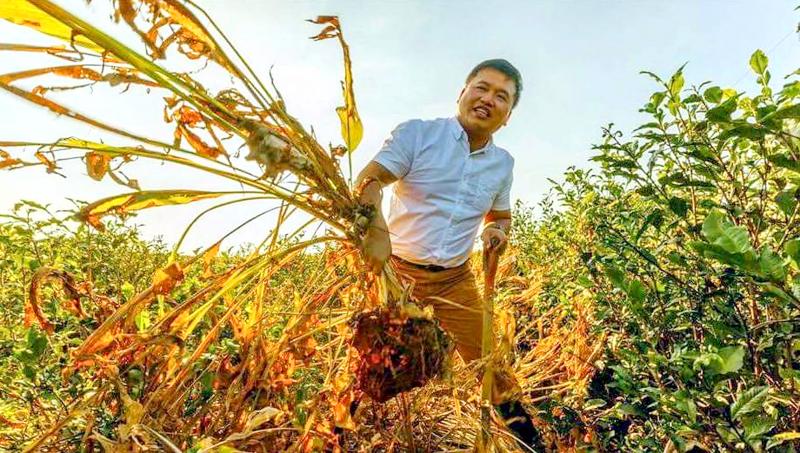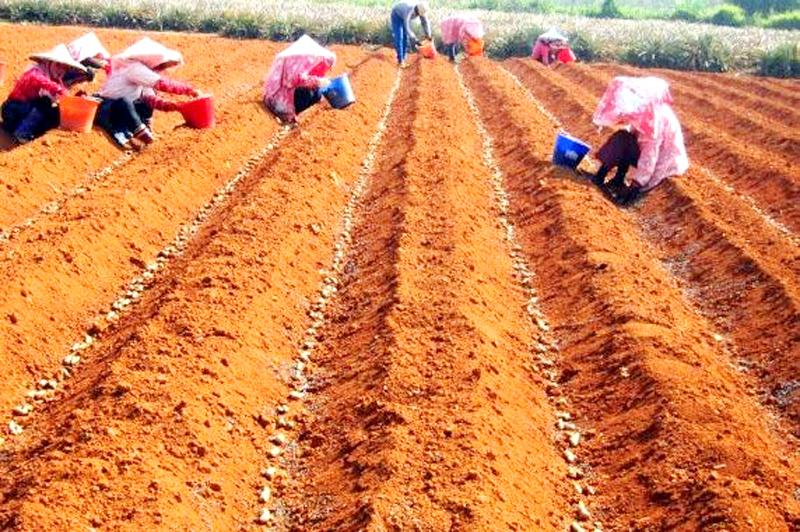As a result of the COVID-19 outbreak, many people are paying increased attention to their health and well-being. Due to the crop’s anti-oxidant and anti-inflammatory properties, Nantou County’s Mingjian Township has experienced a surge in the planting of turmeric for medicinal use. The area set aside in the township to grow turmeric has doubled in size, and orders for turmeric powder are coming in from as far away as the US. Mingjian Township is the center of ginger and turmeric production in Taiwan, both of which have become highly sought after by people trying to protect themselves from the virus.
Mingjian Township farmers mainly used to grow only two crops in the area’s unique red-colored soil, ginger and Chinese yam, but have now added turmeric to the list. Nantou County farmer Hsieh Jui-yu says that since many Westerners eat wheat products as their staple food, he had already been fulfilling orders for turmeric flour for many years. However, Hsieh says it was only after the novel coronavirus outbreak that sales of turmeric power really began to take off. Orders to the US, Europe and South East Asian countries have exploded, making it impossible to keep up with demand, Hsieh says.
Hsieh says that he originally planted four hectares of turmeric, but as a result of the COVID-19 outbreak, this year he plans to plant another two hectares, increasing turmeric production to a total of six hectares on his farm. There are currently approximately 150 hectares of land in the township set aside for ginger production, making Mingjian the crown jewel of Taiwan’s ginger growing industry.

Photo: Hsieh Chieh-yu, Liberty Times 照片:自由時報記者謝介裕
Hsieh holds a doctorate from National Chung Hsing University’s of Department of Agronomy and, in addition to working as a farmer, Hsieh is also an assistant professor at China Medical University and specialises in research into turmeric. Hsieh says that according to international medical research, turmeric is able to suppress influenza, enteroviruses, HIV/AIDS and other diseases. There is also evidence that consumption of turmeric can help to reduce inflammation and regulate the body’s immune system, which is one reason the crop has received so much attention during the ongoing COVID-19 pandemic, Hsieh says.
(Translated by Edward Jones, Taipei Times)
武漢肺炎疫情讓大家更注重養生保健,因為薑黃素有良好的抗氧化和抗發炎功效,南投縣名間鄉掀起種植「薑黃」藥用植物風潮,目前種植面積增加約一倍,連美國也下單訂購薑黃粉,而名間生薑產量也是全台之冠,雙薑成為防疫搶手貨。

Photo: Hsieh Chieh-yu, Liberty Times 照片:自由時報記者謝介裕
名間鄉特有紅色土壤以往以種植生薑、山藥為主,現又多了「薑黃」。南投薑農謝瑞裕表示,西方人多半愛好麵食,長期都有薑黃麵訂單,惟疫情發生以來,薑黃粉外銷歐美、東南亞國家的訂單大幅增加,供不應求。
他原本種植薑黃的面積僅四公頃,因疫情發生以來,今年便將耕種面積再增加兩公頃,合計達六公頃之多。名間種植生薑面積約一百五十公頃,居全台之冠。
畢業於國立中興大學農藝學系博士班的謝瑞裕,不但是農夫,同時也在中國醫藥大學擔任助理教授,且是研究薑黃的專家,他說,根據國際醫學研究,發現薑黃素可抑制流感、腸病毒、愛滋病毒等病毒的活性,且可抗發炎並調節人體免疫力,也是薑黃在防疫期間受大家青睞的主因。
(自由時報記者謝介裕)

A: Hard rock band Guns N’ Roses is touring Taiwan tomorrow. What about pop diva Lady Gaga? B: Unfortunately, Singapore has once again exclusively secured Gaga’s concerts in Asia, just like Taylor Swift’s exclusive Asian shows last year. A: The Singaporean government reportedly paid up to US$2.2 million to secure Swift’s shows. B: And the shows did boost its economy and tourism. A: But I’m angry about this approach, so I’m not going to Gaga’s shows this time. A: 硬式搖滾天團槍與玫瑰明天即將來台,流行天后女神卡卡呢? B: 真可惜,新加坡再度取得卡卡亞洲巡演的獨家主辦權,就像去年泰勒絲的亞洲獨家演出一樣。 A: 據報導新加坡政府付出高達220萬美元,取得泰勒絲的亞洲獨家主辦權。 B: 而她的秀也的確提振了該國的經濟和旅遊業。 A: 但我對此還是很不爽,所以不去新加坡看卡卡了! (By Eddy Chang, Taipei Times/台北時報張迪)

A: Hard rock band Guns N’ Roses and pop diva Lady Gaga are finally touring Asia again. B: Are they also coming to Taiwan? A: The band will stage a show at the Taoyuan Sunlight Arena on Saturday. B: Wow, so this will be the band’s third visit. I really love its 1992 power ballad “November Rain.” The nine-minute hit was the Billboard chart’s longest song at one point. A: Let’s go celebrate the 40th anniversary of its release. A: 硬式搖滾天團槍與玫瑰、女神卡卡終於再度展開亞洲巡演了。 B: 他們也會來台巡演嗎? A: 槍與玫瑰本週六即將在桃園陽光劇場開唱唷。 B: 哇這將是該團第三次來台演出,我超愛他們1992年強力情歌《November Rain》,全長近9分鐘還曾是告示牌排行榜最長神曲。 A: 那我們一起去慶祝該團出道40週年吧! (By Eddy Chang, Taipei Times/台北時報張迪)

Bilingual Story is a fictionalized account. 雙語故事部分內容純屬虛構。 Emma had reviewed 41 resumes that morning. While the ATS screened out 288 unqualified, she screened for AI slop. She could spot it a mile away. She muttered AI buzzwords like curses under her breath. “Team player.” “Results-driven.” “Stakeholder alignment.” “Leveraging core competencies.” Each resume reeked of AI modeling: a cemetery of cliches, tombstones of personality. AI wasn’t just changing hiring. It was draining the humanity from it. Then she found it: a plain PDF cover letter. No template. No design flourishes. The first line read: “I once tried to automate my

Every May 1, Hawaii comes alive with Lei Day, a festival celebrating the rich culture and spirit of the islands. Initiated in 1927 by the poet Don Blanding, Lei Day began as a tribute to the Hawaiian custom of making and wearing leis. The idea was quickly adopted and officially recognized as a holiday in 1929, and leis have since become a symbol of local pride and cultural preservation. In Hawaiian culture, leis are more than decorative garlands made from flowers, shells or feathers. For Hawaiians, giving a lei is as natural as saying “aloha.” It shows love and